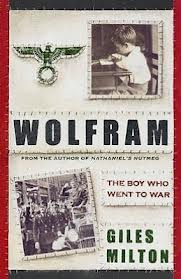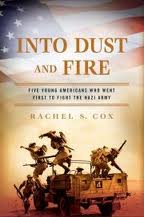Trying To Make Sense Of The Incomprehensible
Bookstores shelve books about the past under the heading of history. Historians have other preferences.
Two new books about World War II highlight the historians’ perspective. Both works were sparked by family histories and both show the strengths and shortcomings of personal history.
In The Boy Who Went to War, Giles Milton recounts the story of Wolfram Aichele, a reluctant German soldier and Milton’s father-in-law. Rachel S. Cox’s Into Dust and Fire recounts the story of five Americans who volunteered to fight the Nazis before the United States was at war. Among the five was Robert Hill Cox II, Rachel Cox’s uncle.
Wolfram’s story is fascinating. The book is described as “narrative non-fiction” It is not history, but it is not fiction, either.
Wolfram grew up in Pforzheim in southwest Germany, a happy boy in a household whose values were strongly anti-Nazi. A talented wood-carver and artists, Wolfram avoided service until he was drafted/coerced into national service. Sent to the Crimea, where he almost died of diphtheria, Wolfram was later re-assigned to France, where he was captured and subsequently sent to a POW camp in Oklahoma. Wolfram’s story and the story of his family reveals the tremendous heartache and horror of World War II. Pforzheim, for example, was firebombed by the British at the end of the war and almost completely obliterated.
The book makes clear its sympathy for many of its characters. It also emphasizes the complete lack on individual knowledge or agency of how lives were completely upended by the conflict.
Milton writes with clarity. His organization is mostly chronological and he links, when possible, local stories with broader historical knowledge. He is acutely conscious of what people knew and what they did not, and his narrative takes pains to give consideration to contextualizing the events faced by his protagonists. The prose helps the reader, too, making accounts lifelike in their detail.
 Cox’s story relies heavily upon the letters of the five: three Dartmouth undergraduates, Charles Bolte, Jack Brister, and Charles McClane, and two Harvard students, Rob Cox and Heyward Cutting. Three of the young men were graduates of St. Paul’s prep school in New Hampshire. They enlisted to see action, to take advantage of an historical tie between America and England, and to serve. The book describes their training in England and their hardships in North Africa. While the three took a courageous step, the machinery of the war treated them with indifference. Three of the young men died and the fourth lost a limb.
Cox’s story relies heavily upon the letters of the five: three Dartmouth undergraduates, Charles Bolte, Jack Brister, and Charles McClane, and two Harvard students, Rob Cox and Heyward Cutting. Three of the young men were graduates of St. Paul’s prep school in New Hampshire. They enlisted to see action, to take advantage of an historical tie between America and England, and to serve. The book describes their training in England and their hardships in North Africa. While the three took a courageous step, the machinery of the war treated them with indifference. Three of the young men died and the fourth lost a limb.
Unfortunately, Cox approach to the text is circuitous. She tries to build tension, but what results is a constant checking for which protagonist in what circumstance. It is a hard book to follow – and I have read reviews that have misunderstood information. The directness of the accounts does add to the reader’s sense of the overall contingent nature of the war, but that’s not necessarily the characteristic that one wants to emphasize. Periodization, structure and organization are problematic.
Even with these shortcomings, the heroism of the young men shines through.
Read in tandem, both works remind us that much remains to be learned about World War II. They also make clear that personal accounts and personal stories are a poor vehicle for historical argument or a broader understanding. Tolstoy’s famous description of the Battle of Borodino in War and Peace , a senseless slaughter carried out in fog and smoke, turns the horror of war into something transcendent. First hand accounts of lives lost and ruined are not art but their accuracy drives home a deep sense of tragedy.